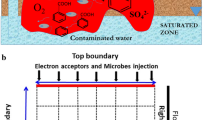Abstract
Groundwater contamination caused by petroleum products has become a common problem. These hazardous chemicals themselves soak down into groundwater through the soil or rock and cause significant health risk. Benzene, one species of chemicals, gives rise to specific concerns due to its relatively high water solubility and toxicity. For the removal of benzene in aquifer, natural biodegradation has indicated its limited ability because of the lack of dissolved oxygen (DO) in groundwater. A new method, namely the slow-release oxygen source (SOS) technique, could increase concentration of dissolved oxygen in groundwater and accelerate biodegradation processes. Therefore, the paper first built a transport model including benzene, DO and microbial species. Relevant program codes were developed on the basis of MODFLOW/MT3DMS. Then, a two-dimensional synthetic aquifer with a point source of benzene was simulated by the modified model to analyze the treatment efficiency of SOS. There were seven schemes designed by using different locations of well and oxygen release rates. Their treatment efficiencies were analyzed. The results showed that the modified model can be used to simulate benzene transport under SOS technique where Monod kinetic reactions occur. It was more efficient when placing release oxygen well was close to contamination sources of groundwater. For the same location of well, higher release rate of oxygen would enhance the effect of bioremediation. Enough dissolved oxygen maybe accelerates the growth of microbial species, and more benzene could be consumed by increasing microbial mass.
Similar content being viewed by others
References
Mater L., Sperb R.M., Madureira L.A.S.; et al.: Proposal of a sequential treatment methodology for the safe reuse of oil sludge-contaminated soil. J. Hazard. Mater. 136(3), 967–971 (2006)
Saponaro S., Negri M., Sezenna E.; et al.: Groundwater remediation by an in situ biobarrier: A bench scale feasibility test for methyl tert-butyl ether and other gasoline compounds. J. Hazard. Mater. 167(1–3), 545–552 (2009)
Yeh C.H., Lin C.W., Wu C.H.: A permeable reactive barrier for the bioremediation of BTEX-contaminated groundwater: Microbial community distribution and removal efficiencies. J. Hazard. Mater. 178(1–3), 74–80 (2010)
Borah D., Yadav R.N.S.: Biodegradation of diesel, crude oil, kerosene and used engine oil by a newly isolated bacillus cereus strain DRDU1 from an automobile engine in liquid culture. Arabian J. Sci. Eng. 39(7), 5337–5345 (2014)
Mascolo G., Ciannarella R., Balest L.; et al.: Effectiveness of UV-based advanced oxidation processes for the remediation of hydrocarbon pollution in the groundwater: A laboratory investigation. J. Hazard. Mater. 152(3), 1138–1145 (2008)
Garoma T., Gurol M.D., Osibodu O. et al.: Treatment of groundwater contaminated with gasoline components by an ozone/UV process. Chemosphere 73(5), 825–831 (2008)
USEPA: A citizen’s guide to bioremediation. United States Environmental Protection Agency, EPA 542-F-12-003 (2012)
USEPA: A citizen’s guide to bioremediation. United States Environmental Protection Agency, EPA 542-F-01-001 (2001)
Rifai H.S., Rittale T.: Modeling natural attenuation of benzene with analytical and numerical models. Biodegradation 16(4), 291–304 (2005)
Davis, H.W.J.; Vesper, S.J.: Process for the biodegradation of hydrocarbons and ethers in subsurface soil by introduction of a solid oxygen source by hydraulic fracturing. United States Patent: US 7,252,986 B2, Aug.7 (2007)
Davis, H.W.J.; Vesper, S.J.: Slow-releasing oxygen source. Presented at The World’s Best Technologies Conference, Dallas, TX, May 14–15 (2008)
Yang, A.L.; Huang, G.H.; Qin, X.S.; et al.: Evaluation of remedial options for a benzene-contaminated site through a simulation-based fuzzy-MCDA approach. J. Hazard. Mater. 213–214, 421–433 (2012)
Clement, T.P.: RT3D-A Modular Computer Code for Simulating Reactive Multi-Species Transport in 3-Dimensional Groundwater Aquifers. PNNL-11720 Pacific Northwest National Laboratory, Richland, Washington, USA (1997)
Clement T.P.: RT3D V2.5 Updates to User’s Guide. Pacific Northwest National Laboratory, Richland (2003)
Gomez, D.E.; Blanc, P.C.; Rixey, W.G.; et al.: Modeling benzene plume elongation mechanisms exerted by ethanol using RT3D with a general substrate interaction module. Water Resour. Res. 44, W05405 (2008)
Gomez, D.E.; Alvarez, P.J.J.: Modeling the natural attenuation of benzene in groundwater impacted by ethanol-blended fuels: effect of ethanol content on the lifespan and maximum length of benzene plumes. Water Resour. Res. 45, W03409 (2008)
Gomez D.E., Alvarez P.J.J.: Comparing the effects of various fuel alcohols on the natural attenuation of benzene plumes using a general substrate interaction model. J Contam. Hydrol. 113(1–4), 66–76 (2010)
Harbaugh, A.W.: MODFLOW-2005, The U.S. Geological Survey, Modular ground-water model-the ground-water flow process. U.S. Geological Survey Techniques and Methods 6-A16 (2005)
Zheng C.M.: MT3DMS v5.2 Supplemental User’s Guide. Department of Geological Sciences, University of Alabama, Alabama (2006)
Zheng C.M.: Recent developments and future directions for MT3DMS and related transport codes. Groundwater 47(5), 620–625 (2009)
Jordi B.A., Serge B., Alain D.; et al.: Benzene dispersion and natural attenuation in an alluvial with strong interactions with surface water. J. Hydrol. 369(3–4), 305–317 (2009)
Mohamed M.A., Hatfield Kirk H.A.E.: Monte Carlo evaluation of microbial-mediated contaminant reactions in heterogeneous aquifers. Advances in water resources 29(8), 1123–1139 (2006)
Mohamed M.A.M., Saleh E.N., Sherif M.M.: Modeling in situ benzene bioremediation in the contaminated Liwa aquifer (UAE) using the slow-release oxygen source technique. Environ. Earth Sci. 61(7), 1385–1399 (2010)
Zheng C.M.: MT3DMS v5.3 Supplemental User’s Guide. Department of Geological Sciences, University of Alabama, Alabama (2009)
Zheng C.M., Bennett G.D.: Applied Contaminant Transport Modeling (2nd edn). Higher Education Press, Beijing (2009)
Rifai, H.S.; Newell, C.J.; Gonzales, J.R.: Bioplume III, Natural Attenuation Decision Support System, (Version 1.0) User’s Manual, Air Force Center for environmental excellence, Brooks AFB, San Antonio, TX (1997)
USGS: http://water.usgs.gov/nrp/gwsoftware/modflow2005/modflow2005.html (2013)
The University of Alabama: http://hydro.geo.ua.edu/mt3d/ (2010)
Prommer H., Barry D.A., Davis G.B.: A one-dimensional reactive multi-component transport model for biodegradation of petroleum hydrocarbons in ground water. Environ. Model. Softw. 14, 213–223 (1999)
Author information
Authors and Affiliations
Corresponding authors
Rights and permissions
About this article
Cite this article
Zengguang, X., Yanlong, L., Junrui, C. et al. Bioremediation Modeling of an Aquifer Contaminated by Benzene Using the Slow-Release Oxygen Source Technique. Arab J Sci Eng 40, 2457–2463 (2015). https://doi.org/10.1007/s13369-015-1637-6
Received:
Accepted:
Published:
Issue Date:
DOI: https://doi.org/10.1007/s13369-015-1637-6




